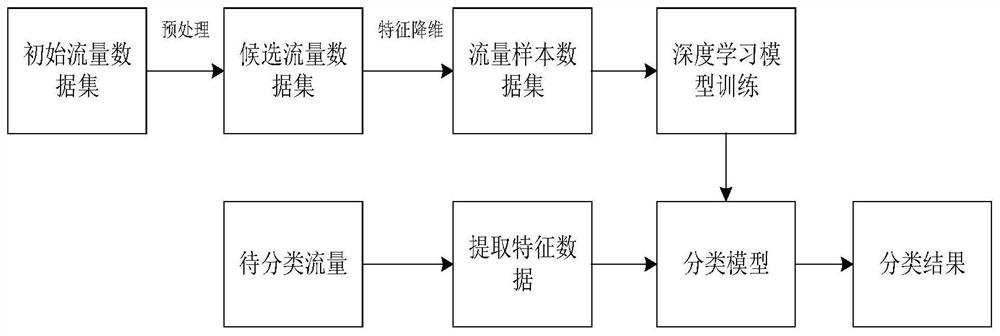Information transmission scheduling method and system based on intelligent traffic classification
A traffic classification and information transmission technology, which is applied in the information transmission scheduling method and system field based on intelligent traffic classification, can solve the problem of unrecognizable high-priority data types in the Internet of Things, difficulty in meeting user service quality requirements, and insufficient guarantee of network resource allocation and other issues, to achieve the effect of improving sample validity, network resource allocation guarantee, and training effect
- Summary
- Abstract
- Description
- Claims
- Application Information
AI Technical Summary
Problems solved by technology
Method used
Image
Examples
Embodiment 1
[0064] Such as Figure 1 to Figure 3 As shown, an information transmission scheduling method based on intelligent traffic classification includes the following steps:
[0065] S1, prepare training data: make the network traffic data set into a traffic feature training set, which is used as the input of the neural network;
[0066] S2, build a neural network: use the classification network to establish a short connection between all the previous layers and the back layer, and build a neural network;
[0067] S3, train the neural network: use the traffic feature training set in step S1 as the input of the neural network, input it into the neural network for training, and obtain the traffic classification model;
[0068] S4, classify the traffic category: classify the traffic data to be processed according to the traffic classification model;
[0069] S5. Perform traffic transmission scheduling: divide the classified traffic data into specific priority levels according to the p...
Embodiment 2
[0097] Such as Figure 1 to Figure 3 As shown, on the basis of the embodiment, this embodiment provides a system of an information transmission scheduling method based on intelligent traffic classification, including the following modules:
[0098] The traffic classification module is used for traffic acquisition, feature extraction and traffic classification of the traffic data to be processed, and information interaction with the network traffic control module.
[0099] Network traffic control module: used for policy matching and traffic forwarding control on classified traffic, and information interaction with traffic classification module, data collection and distribution module;
[0100] Data collection and distribution module: used for two-level scheduling of traffic data. The first level uses weighted scheduling to schedule traffic data packets of different priorities according to the order of priority; the second level uses round-robin scheduling to According to the f...
Embodiment 3
[0106] Such as Figure 1 to Figure 3 As shown, as a further optimization of Embodiment 1 and Embodiment 2, this embodiment includes all the technical features of Embodiment 1 and Embodiment 2. In addition, this embodiment has further refinements and supplements.
[0107] An information transmission scheduling method based on intelligent traffic classification, comprising the following steps:
[0108] S1, prepare training data: make the network traffic data set into a traffic feature training set, which is used as the input of the neural network;
[0109] The data set used in the present invention is a classic Moore network traffic data set, which is the traffic data of Cambridge University collected by Moore et al., and is used in the field of network traffic identification and classification. The data of each flow in this dataset has 12 feature vectors and 1 manually labeled category label. According to the Internet communication standard document, a network flow is defined...
PUM
 Login to View More
Login to View More Abstract
Description
Claims
Application Information
 Login to View More
Login to View More - R&D
- Intellectual Property
- Life Sciences
- Materials
- Tech Scout
- Unparalleled Data Quality
- Higher Quality Content
- 60% Fewer Hallucinations
Browse by: Latest US Patents, China's latest patents, Technical Efficacy Thesaurus, Application Domain, Technology Topic, Popular Technical Reports.
© 2025 PatSnap. All rights reserved.Legal|Privacy policy|Modern Slavery Act Transparency Statement|Sitemap|About US| Contact US: help@patsnap.com



